LQB387 Practical Report: Enzyme-Linked Immunosorbent Assay Analysis
VerifiedAdded on 2023/06/12
|10
|2339
|261
Report
AI Summary
This report details an Enzyme-Linked Immunosorbent Assay (ELISA) experiment, focusing on the indirect ELISA method to detect measles virus antibodies. The experiment aims to determine the immune status of test samples to measles, utilizing immunology principles and labeled reagents. The procedure involves coating microtitre plate wells with measles viral antigen, adding control and patient serum dilutions, and detecting antibody binding with an HRP-conjugated anti-human IgG. Absorbance readings at 450 nm are used to determine the presence of measles antibodies in patient samples. Results indicate whether patients tested positive or negative for measles virus, with data analysis employing qualitative methods. The report also discusses various types of ELISA assays and their applications in diagnosing diseases like HIV, influenza, and Ebola. Desklib offers a wealth of resources, including past papers and solved assignments, to support students in their studies.

University
Enzyme-Linked Immunosorbent Assay
Subtitle
Name
Course Name and Number
Professor’s Name
Paper Due Date
Enzyme-Linked Immunosorbent Assay
Subtitle
Name
Course Name and Number
Professor’s Name
Paper Due Date
Paraphrase This Document
Need a fresh take? Get an instant paraphrase of this document with our AI Paraphraser
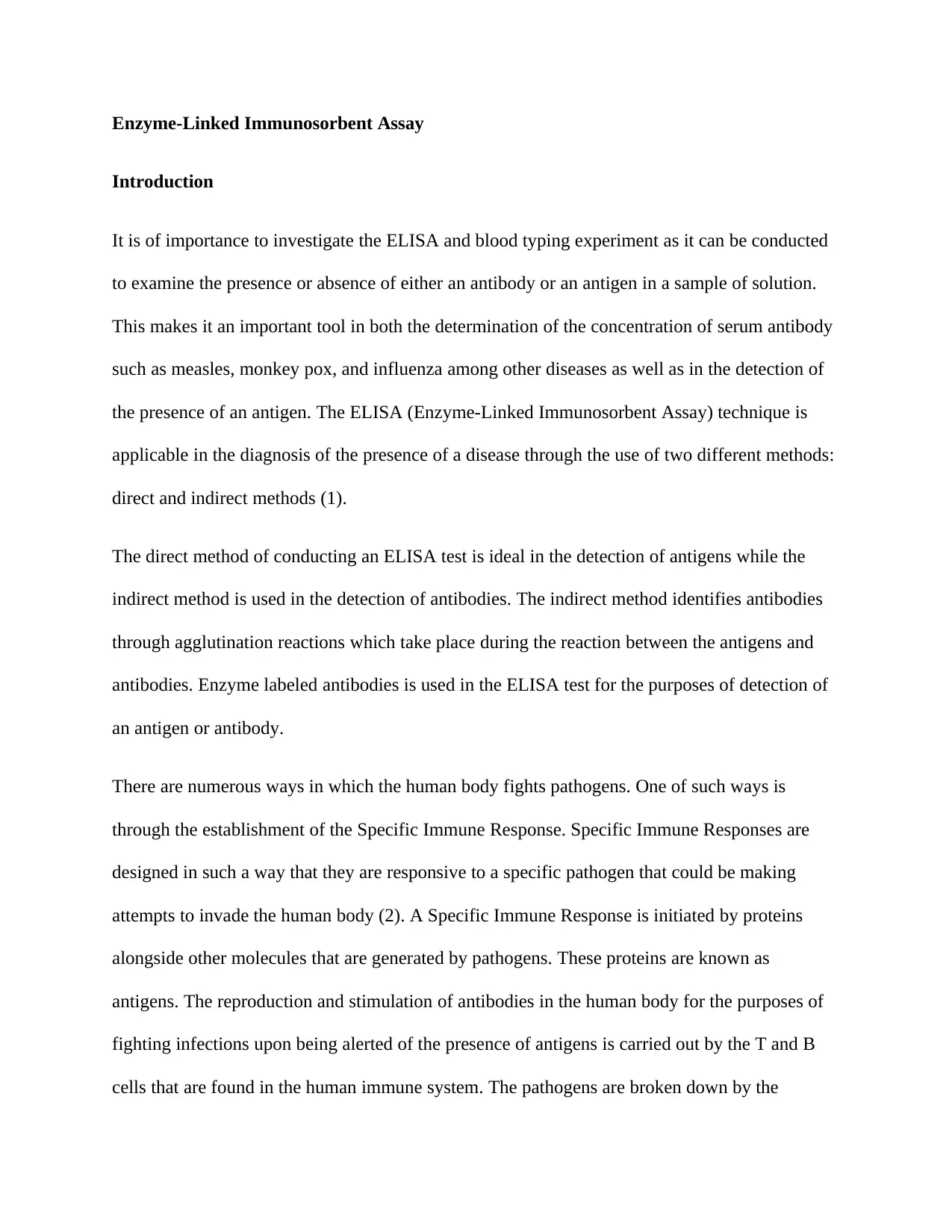
Enzyme-Linked Immunosorbent Assay
Introduction
It is of importance to investigate the ELISA and blood typing experiment as it can be conducted
to examine the presence or absence of either an antibody or an antigen in a sample of solution.
This makes it an important tool in both the determination of the concentration of serum antibody
such as measles, monkey pox, and influenza among other diseases as well as in the detection of
the presence of an antigen. The ELISA (Enzyme-Linked Immunosorbent Assay) technique is
applicable in the diagnosis of the presence of a disease through the use of two different methods:
direct and indirect methods (1).
The direct method of conducting an ELISA test is ideal in the detection of antigens while the
indirect method is used in the detection of antibodies. The indirect method identifies antibodies
through agglutination reactions which take place during the reaction between the antigens and
antibodies. Enzyme labeled antibodies is used in the ELISA test for the purposes of detection of
an antigen or antibody.
There are numerous ways in which the human body fights pathogens. One of such ways is
through the establishment of the Specific Immune Response. Specific Immune Responses are
designed in such a way that they are responsive to a specific pathogen that could be making
attempts to invade the human body (2). A Specific Immune Response is initiated by proteins
alongside other molecules that are generated by pathogens. These proteins are known as
antigens. The reproduction and stimulation of antibodies in the human body for the purposes of
fighting infections upon being alerted of the presence of antigens is carried out by the T and B
cells that are found in the human immune system. The pathogens are broken down by the
Introduction
It is of importance to investigate the ELISA and blood typing experiment as it can be conducted
to examine the presence or absence of either an antibody or an antigen in a sample of solution.
This makes it an important tool in both the determination of the concentration of serum antibody
such as measles, monkey pox, and influenza among other diseases as well as in the detection of
the presence of an antigen. The ELISA (Enzyme-Linked Immunosorbent Assay) technique is
applicable in the diagnosis of the presence of a disease through the use of two different methods:
direct and indirect methods (1).
The direct method of conducting an ELISA test is ideal in the detection of antigens while the
indirect method is used in the detection of antibodies. The indirect method identifies antibodies
through agglutination reactions which take place during the reaction between the antigens and
antibodies. Enzyme labeled antibodies is used in the ELISA test for the purposes of detection of
an antigen or antibody.
There are numerous ways in which the human body fights pathogens. One of such ways is
through the establishment of the Specific Immune Response. Specific Immune Responses are
designed in such a way that they are responsive to a specific pathogen that could be making
attempts to invade the human body (2). A Specific Immune Response is initiated by proteins
alongside other molecules that are generated by pathogens. These proteins are known as
antigens. The reproduction and stimulation of antibodies in the human body for the purposes of
fighting infections upon being alerted of the presence of antigens is carried out by the T and B
cells that are found in the human immune system. The pathogens are broken down by the

phagocytic microphages which also display the molecules of antigens for recognition by the
lymphocytes (3).
Antibodies are defined as immunoglobulin responsible for the binding of antigens and labeling
them for destruction. This experiment uses the indirect ELISA test. The indirect ELISA test is a
test used in finding pathogenic infection through acknowledging the presence of antibodies in the
e human blood. The purpose of this experiment is to utilize multi-step assay in testing samples
for infection of a specified pathogen, in this case measles, which is a highly dangerous disease
caused by a virus known as paramyxovirus.
Aim
To investigate the hypothesis that there is a decrease in the spectrophotometer reading with an
increase in the dilution of the well from the 1st to the 12th well
Objectives
To conduct an indirect ELISA test technique for use in the determination of the immune
status to measles virus in test sample
To adopt the knowledge of immunology and incorporate the testing principles by ELISA
and the utilization of labeled reagents
Materials and Methods
1. Have all the regents at room temperatures
2. Handle the 12-well plastic strip carefully from the kit and place it in a carrier frame
3. Pipette 50 uL of measles viral antigen (simulated) to all the wells of the strip
4. Cover the strip and incubate it for 15 minutes (during this time, perform steps 5 and 6)
lymphocytes (3).
Antibodies are defined as immunoglobulin responsible for the binding of antigens and labeling
them for destruction. This experiment uses the indirect ELISA test. The indirect ELISA test is a
test used in finding pathogenic infection through acknowledging the presence of antibodies in the
e human blood. The purpose of this experiment is to utilize multi-step assay in testing samples
for infection of a specified pathogen, in this case measles, which is a highly dangerous disease
caused by a virus known as paramyxovirus.
Aim
To investigate the hypothesis that there is a decrease in the spectrophotometer reading with an
increase in the dilution of the well from the 1st to the 12th well
Objectives
To conduct an indirect ELISA test technique for use in the determination of the immune
status to measles virus in test sample
To adopt the knowledge of immunology and incorporate the testing principles by ELISA
and the utilization of labeled reagents
Materials and Methods
1. Have all the regents at room temperatures
2. Handle the 12-well plastic strip carefully from the kit and place it in a carrier frame
3. Pipette 50 uL of measles viral antigen (simulated) to all the wells of the strip
4. Cover the strip and incubate it for 15 minutes (during this time, perform steps 5 and 6)
⊘ This is a preview!⊘
Do you want full access?
Subscribe today to unlock all pages.

Trusted by 1+ million students worldwide
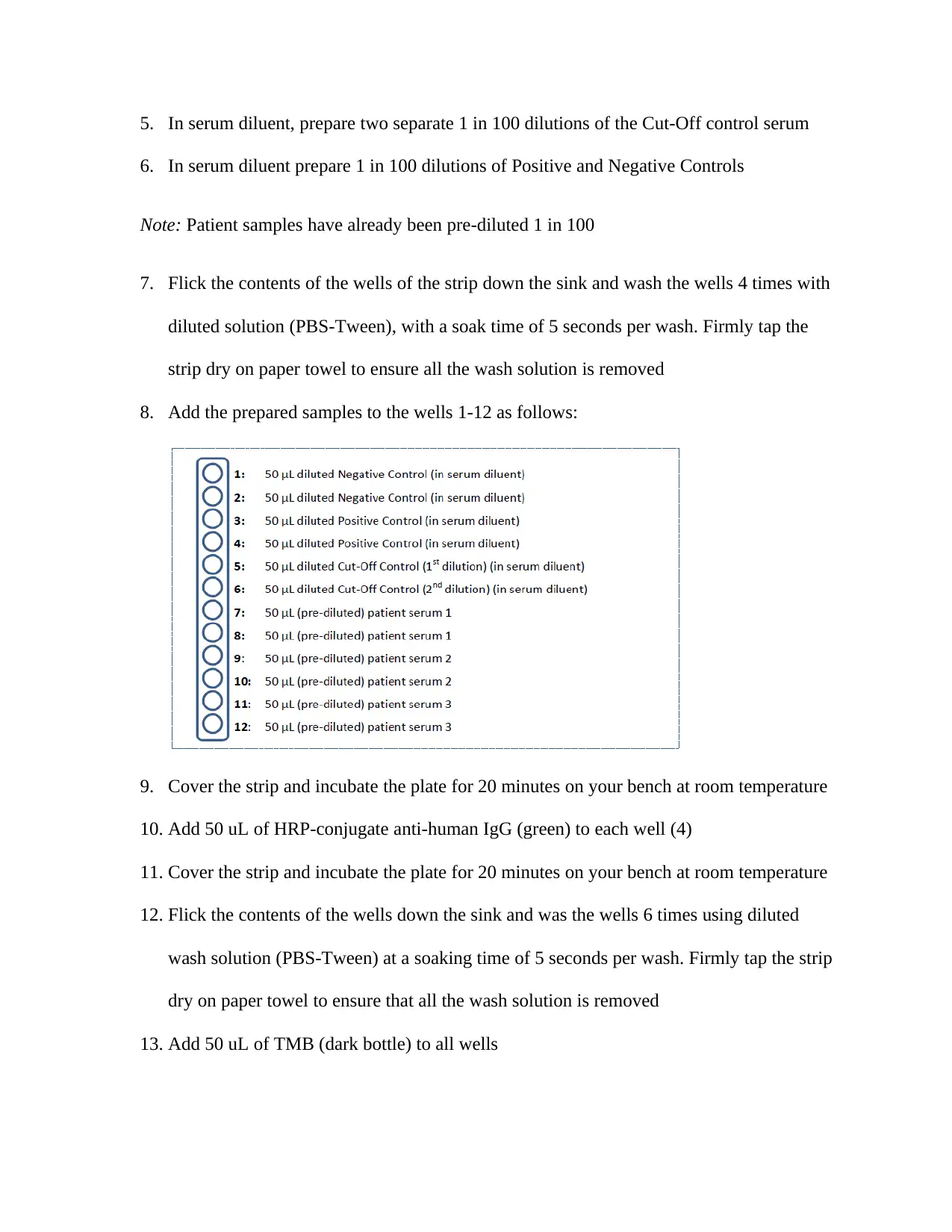
5. In serum diluent, prepare two separate 1 in 100 dilutions of the Cut-Off control serum
6. In serum diluent prepare 1 in 100 dilutions of Positive and Negative Controls
Note: Patient samples have already been pre-diluted 1 in 100
7. Flick the contents of the wells of the strip down the sink and wash the wells 4 times with
diluted solution (PBS-Tween), with a soak time of 5 seconds per wash. Firmly tap the
strip dry on paper towel to ensure all the wash solution is removed
8. Add the prepared samples to the wells 1-12 as follows:
9. Cover the strip and incubate the plate for 20 minutes on your bench at room temperature
10. Add 50 uL of HRP-conjugate anti-human IgG (green) to each well (4)
11. Cover the strip and incubate the plate for 20 minutes on your bench at room temperature
12. Flick the contents of the wells down the sink and was the wells 6 times using diluted
wash solution (PBS-Tween) at a soaking time of 5 seconds per wash. Firmly tap the strip
dry on paper towel to ensure that all the wash solution is removed
13. Add 50 uL of TMB (dark bottle) to all wells
6. In serum diluent prepare 1 in 100 dilutions of Positive and Negative Controls
Note: Patient samples have already been pre-diluted 1 in 100
7. Flick the contents of the wells of the strip down the sink and wash the wells 4 times with
diluted solution (PBS-Tween), with a soak time of 5 seconds per wash. Firmly tap the
strip dry on paper towel to ensure all the wash solution is removed
8. Add the prepared samples to the wells 1-12 as follows:
9. Cover the strip and incubate the plate for 20 minutes on your bench at room temperature
10. Add 50 uL of HRP-conjugate anti-human IgG (green) to each well (4)
11. Cover the strip and incubate the plate for 20 minutes on your bench at room temperature
12. Flick the contents of the wells down the sink and was the wells 6 times using diluted
wash solution (PBS-Tween) at a soaking time of 5 seconds per wash. Firmly tap the strip
dry on paper towel to ensure that all the wash solution is removed
13. Add 50 uL of TMB (dark bottle) to all wells
Paraphrase This Document
Need a fresh take? Get an instant paraphrase of this document with our AI Paraphraser
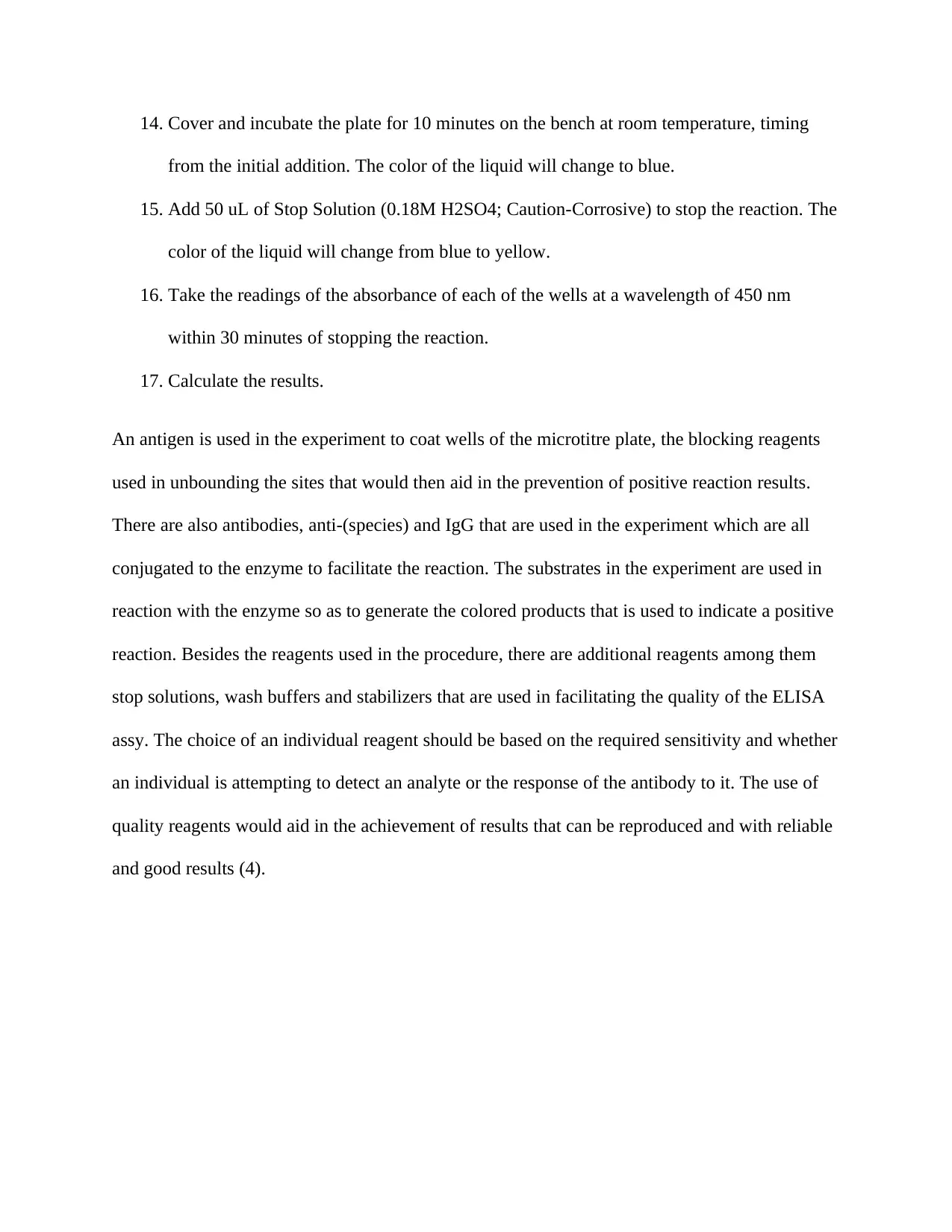
14. Cover and incubate the plate for 10 minutes on the bench at room temperature, timing
from the initial addition. The color of the liquid will change to blue.
15. Add 50 uL of Stop Solution (0.18M H2SO4; Caution-Corrosive) to stop the reaction. The
color of the liquid will change from blue to yellow.
16. Take the readings of the absorbance of each of the wells at a wavelength of 450 nm
within 30 minutes of stopping the reaction.
17. Calculate the results.
An antigen is used in the experiment to coat wells of the microtitre plate, the blocking reagents
used in unbounding the sites that would then aid in the prevention of positive reaction results.
There are also antibodies, anti-(species) and IgG that are used in the experiment which are all
conjugated to the enzyme to facilitate the reaction. The substrates in the experiment are used in
reaction with the enzyme so as to generate the colored products that is used to indicate a positive
reaction. Besides the reagents used in the procedure, there are additional reagents among them
stop solutions, wash buffers and stabilizers that are used in facilitating the quality of the ELISA
assy. The choice of an individual reagent should be based on the required sensitivity and whether
an individual is attempting to detect an analyte or the response of the antibody to it. The use of
quality reagents would aid in the achievement of results that can be reproduced and with reliable
and good results (4).
from the initial addition. The color of the liquid will change to blue.
15. Add 50 uL of Stop Solution (0.18M H2SO4; Caution-Corrosive) to stop the reaction. The
color of the liquid will change from blue to yellow.
16. Take the readings of the absorbance of each of the wells at a wavelength of 450 nm
within 30 minutes of stopping the reaction.
17. Calculate the results.
An antigen is used in the experiment to coat wells of the microtitre plate, the blocking reagents
used in unbounding the sites that would then aid in the prevention of positive reaction results.
There are also antibodies, anti-(species) and IgG that are used in the experiment which are all
conjugated to the enzyme to facilitate the reaction. The substrates in the experiment are used in
reaction with the enzyme so as to generate the colored products that is used to indicate a positive
reaction. Besides the reagents used in the procedure, there are additional reagents among them
stop solutions, wash buffers and stabilizers that are used in facilitating the quality of the ELISA
assy. The choice of an individual reagent should be based on the required sensitivity and whether
an individual is attempting to detect an analyte or the response of the antibody to it. The use of
quality reagents would aid in the achievement of results that can be reproduced and with reliable
and good results (4).
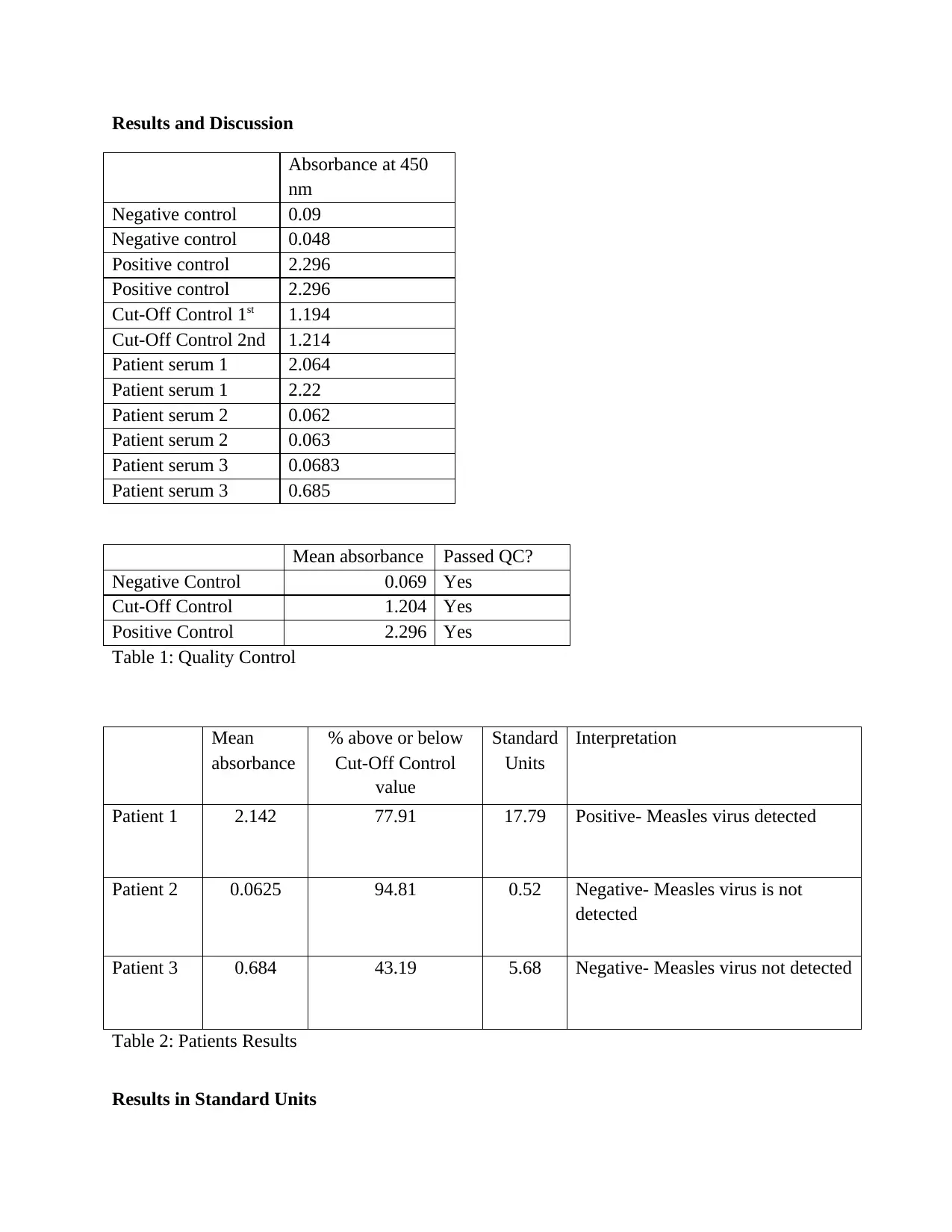
Results and Discussion
Absorbance at 450
nm
Negative control 0.09
Negative control 0.048
Positive control 2.296
Positive control 2.296
Cut-Off Control 1st 1.194
Cut-Off Control 2nd 1.214
Patient serum 1 2.064
Patient serum 1 2.22
Patient serum 2 0.062
Patient serum 2 0.063
Patient serum 3 0.0683
Patient serum 3 0.685
Mean absorbance Passed QC?
Negative Control 0.069 Yes
Cut-Off Control 1.204 Yes
Positive Control 2.296 Yes
Table 1: Quality Control
Mean
absorbance
% above or below
Cut-Off Control
value
Standard
Units
Interpretation
Patient 1 2.142 77.91 17.79 Positive- Measles virus detected
Patient 2 0.0625 94.81 0.52 Negative- Measles virus is not
detected
Patient 3 0.684 43.19 5.68 Negative- Measles virus not detected
Table 2: Patients Results
Results in Standard Units
Absorbance at 450
nm
Negative control 0.09
Negative control 0.048
Positive control 2.296
Positive control 2.296
Cut-Off Control 1st 1.194
Cut-Off Control 2nd 1.214
Patient serum 1 2.064
Patient serum 1 2.22
Patient serum 2 0.062
Patient serum 2 0.063
Patient serum 3 0.0683
Patient serum 3 0.685
Mean absorbance Passed QC?
Negative Control 0.069 Yes
Cut-Off Control 1.204 Yes
Positive Control 2.296 Yes
Table 1: Quality Control
Mean
absorbance
% above or below
Cut-Off Control
value
Standard
Units
Interpretation
Patient 1 2.142 77.91 17.79 Positive- Measles virus detected
Patient 2 0.0625 94.81 0.52 Negative- Measles virus is not
detected
Patient 3 0.684 43.19 5.68 Negative- Measles virus not detected
Table 2: Patients Results
Results in Standard Units
⊘ This is a preview!⊘
Do you want full access?
Subscribe today to unlock all pages.

Trusted by 1+ million students worldwide
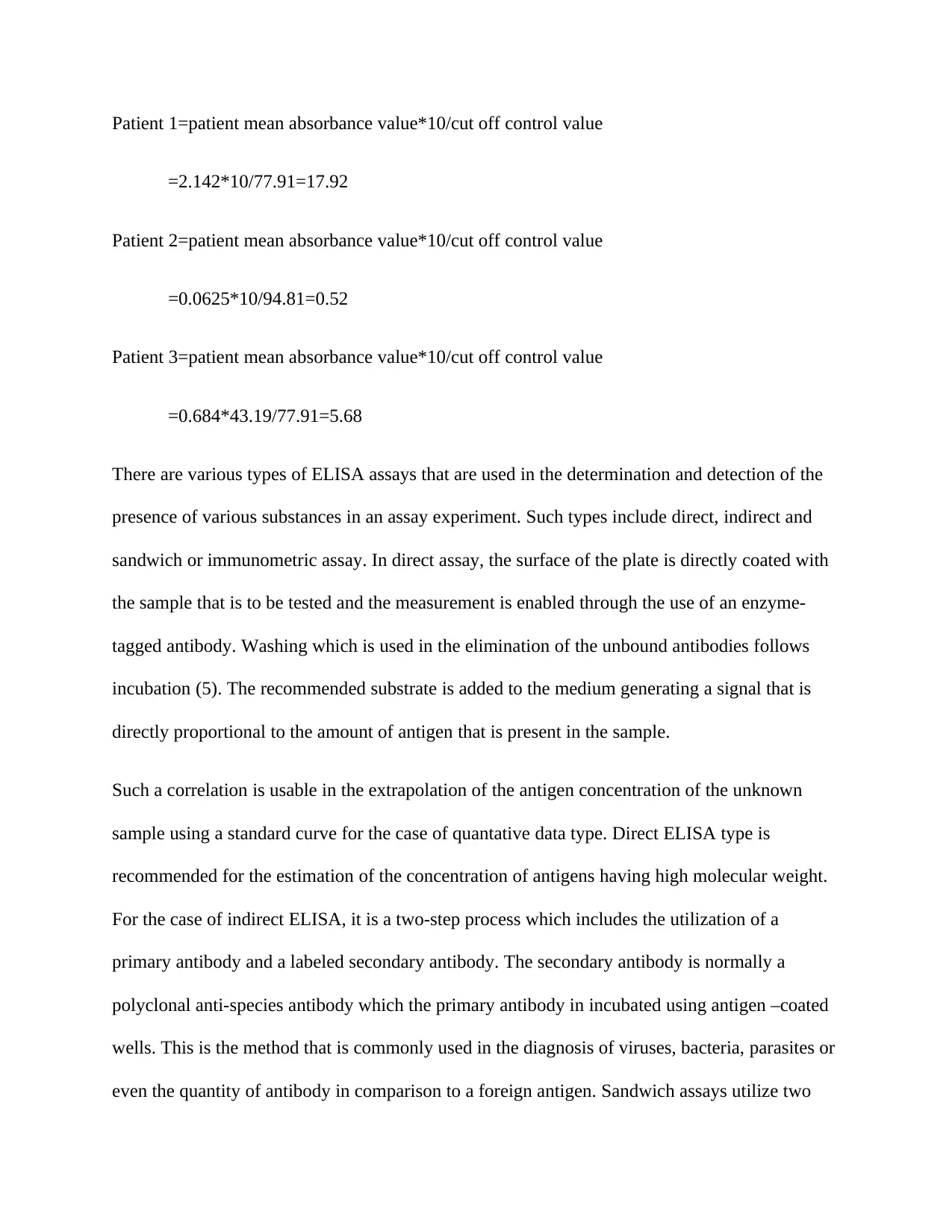
Patient 1=patient mean absorbance value*10/cut off control value
=2.142*10/77.91=17.92
Patient 2=patient mean absorbance value*10/cut off control value
=0.0625*10/94.81=0.52
Patient 3=patient mean absorbance value*10/cut off control value
=0.684*43.19/77.91=5.68
There are various types of ELISA assays that are used in the determination and detection of the
presence of various substances in an assay experiment. Such types include direct, indirect and
sandwich or immunometric assay. In direct assay, the surface of the plate is directly coated with
the sample that is to be tested and the measurement is enabled through the use of an enzyme-
tagged antibody. Washing which is used in the elimination of the unbound antibodies follows
incubation (5). The recommended substrate is added to the medium generating a signal that is
directly proportional to the amount of antigen that is present in the sample.
Such a correlation is usable in the extrapolation of the antigen concentration of the unknown
sample using a standard curve for the case of quantative data type. Direct ELISA type is
recommended for the estimation of the concentration of antigens having high molecular weight.
For the case of indirect ELISA, it is a two-step process which includes the utilization of a
primary antibody and a labeled secondary antibody. The secondary antibody is normally a
polyclonal anti-species antibody which the primary antibody in incubated using antigen –coated
wells. This is the method that is commonly used in the diagnosis of viruses, bacteria, parasites or
even the quantity of antibody in comparison to a foreign antigen. Sandwich assays utilize two
=2.142*10/77.91=17.92
Patient 2=patient mean absorbance value*10/cut off control value
=0.0625*10/94.81=0.52
Patient 3=patient mean absorbance value*10/cut off control value
=0.684*43.19/77.91=5.68
There are various types of ELISA assays that are used in the determination and detection of the
presence of various substances in an assay experiment. Such types include direct, indirect and
sandwich or immunometric assay. In direct assay, the surface of the plate is directly coated with
the sample that is to be tested and the measurement is enabled through the use of an enzyme-
tagged antibody. Washing which is used in the elimination of the unbound antibodies follows
incubation (5). The recommended substrate is added to the medium generating a signal that is
directly proportional to the amount of antigen that is present in the sample.
Such a correlation is usable in the extrapolation of the antigen concentration of the unknown
sample using a standard curve for the case of quantative data type. Direct ELISA type is
recommended for the estimation of the concentration of antigens having high molecular weight.
For the case of indirect ELISA, it is a two-step process which includes the utilization of a
primary antibody and a labeled secondary antibody. The secondary antibody is normally a
polyclonal anti-species antibody which the primary antibody in incubated using antigen –coated
wells. This is the method that is commonly used in the diagnosis of viruses, bacteria, parasites or
even the quantity of antibody in comparison to a foreign antigen. Sandwich assays utilize two
Paraphrase This Document
Need a fresh take? Get an instant paraphrase of this document with our AI Paraphraser
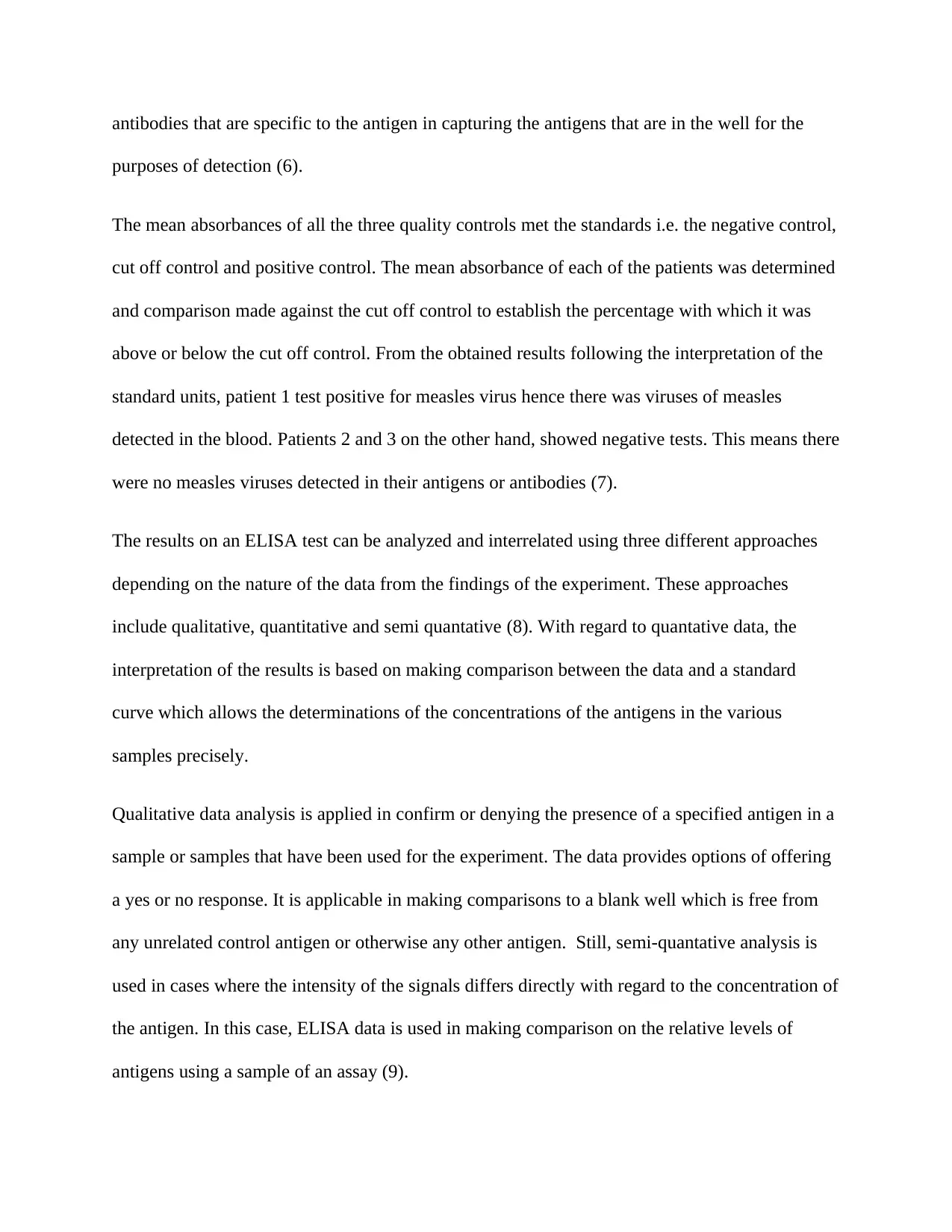
antibodies that are specific to the antigen in capturing the antigens that are in the well for the
purposes of detection (6).
The mean absorbances of all the three quality controls met the standards i.e. the negative control,
cut off control and positive control. The mean absorbance of each of the patients was determined
and comparison made against the cut off control to establish the percentage with which it was
above or below the cut off control. From the obtained results following the interpretation of the
standard units, patient 1 test positive for measles virus hence there was viruses of measles
detected in the blood. Patients 2 and 3 on the other hand, showed negative tests. This means there
were no measles viruses detected in their antigens or antibodies (7).
The results on an ELISA test can be analyzed and interrelated using three different approaches
depending on the nature of the data from the findings of the experiment. These approaches
include qualitative, quantitative and semi quantative (8). With regard to quantative data, the
interpretation of the results is based on making comparison between the data and a standard
curve which allows the determinations of the concentrations of the antigens in the various
samples precisely.
Qualitative data analysis is applied in confirm or denying the presence of a specified antigen in a
sample or samples that have been used for the experiment. The data provides options of offering
a yes or no response. It is applicable in making comparisons to a blank well which is free from
any unrelated control antigen or otherwise any other antigen. Still, semi-quantative analysis is
used in cases where the intensity of the signals differs directly with regard to the concentration of
the antigen. In this case, ELISA data is used in making comparison on the relative levels of
antigens using a sample of an assay (9).
purposes of detection (6).
The mean absorbances of all the three quality controls met the standards i.e. the negative control,
cut off control and positive control. The mean absorbance of each of the patients was determined
and comparison made against the cut off control to establish the percentage with which it was
above or below the cut off control. From the obtained results following the interpretation of the
standard units, patient 1 test positive for measles virus hence there was viruses of measles
detected in the blood. Patients 2 and 3 on the other hand, showed negative tests. This means there
were no measles viruses detected in their antigens or antibodies (7).
The results on an ELISA test can be analyzed and interrelated using three different approaches
depending on the nature of the data from the findings of the experiment. These approaches
include qualitative, quantitative and semi quantative (8). With regard to quantative data, the
interpretation of the results is based on making comparison between the data and a standard
curve which allows the determinations of the concentrations of the antigens in the various
samples precisely.
Qualitative data analysis is applied in confirm or denying the presence of a specified antigen in a
sample or samples that have been used for the experiment. The data provides options of offering
a yes or no response. It is applicable in making comparisons to a blank well which is free from
any unrelated control antigen or otherwise any other antigen. Still, semi-quantative analysis is
used in cases where the intensity of the signals differs directly with regard to the concentration of
the antigen. In this case, ELISA data is used in making comparison on the relative levels of
antigens using a sample of an assay (9).
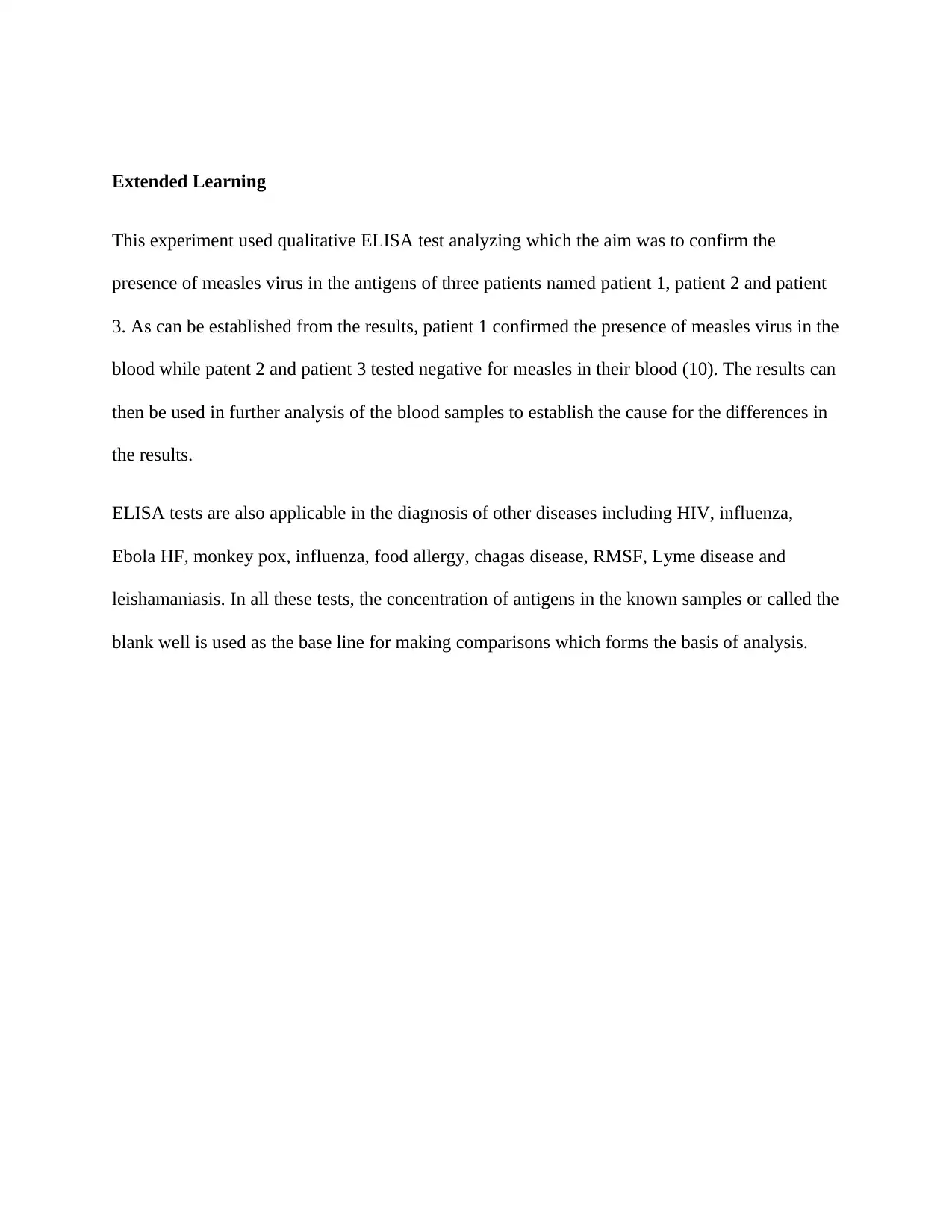
Extended Learning
This experiment used qualitative ELISA test analyzing which the aim was to confirm the
presence of measles virus in the antigens of three patients named patient 1, patient 2 and patient
3. As can be established from the results, patient 1 confirmed the presence of measles virus in the
blood while patent 2 and patient 3 tested negative for measles in their blood (10). The results can
then be used in further analysis of the blood samples to establish the cause for the differences in
the results.
ELISA tests are also applicable in the diagnosis of other diseases including HIV, influenza,
Ebola HF, monkey pox, influenza, food allergy, chagas disease, RMSF, Lyme disease and
leishamaniasis. In all these tests, the concentration of antigens in the known samples or called the
blank well is used as the base line for making comparisons which forms the basis of analysis.
This experiment used qualitative ELISA test analyzing which the aim was to confirm the
presence of measles virus in the antigens of three patients named patient 1, patient 2 and patient
3. As can be established from the results, patient 1 confirmed the presence of measles virus in the
blood while patent 2 and patient 3 tested negative for measles in their blood (10). The results can
then be used in further analysis of the blood samples to establish the cause for the differences in
the results.
ELISA tests are also applicable in the diagnosis of other diseases including HIV, influenza,
Ebola HF, monkey pox, influenza, food allergy, chagas disease, RMSF, Lyme disease and
leishamaniasis. In all these tests, the concentration of antigens in the known samples or called the
blank well is used as the base line for making comparisons which forms the basis of analysis.
⊘ This is a preview!⊘
Do you want full access?
Subscribe today to unlock all pages.

Trusted by 1+ million students worldwide
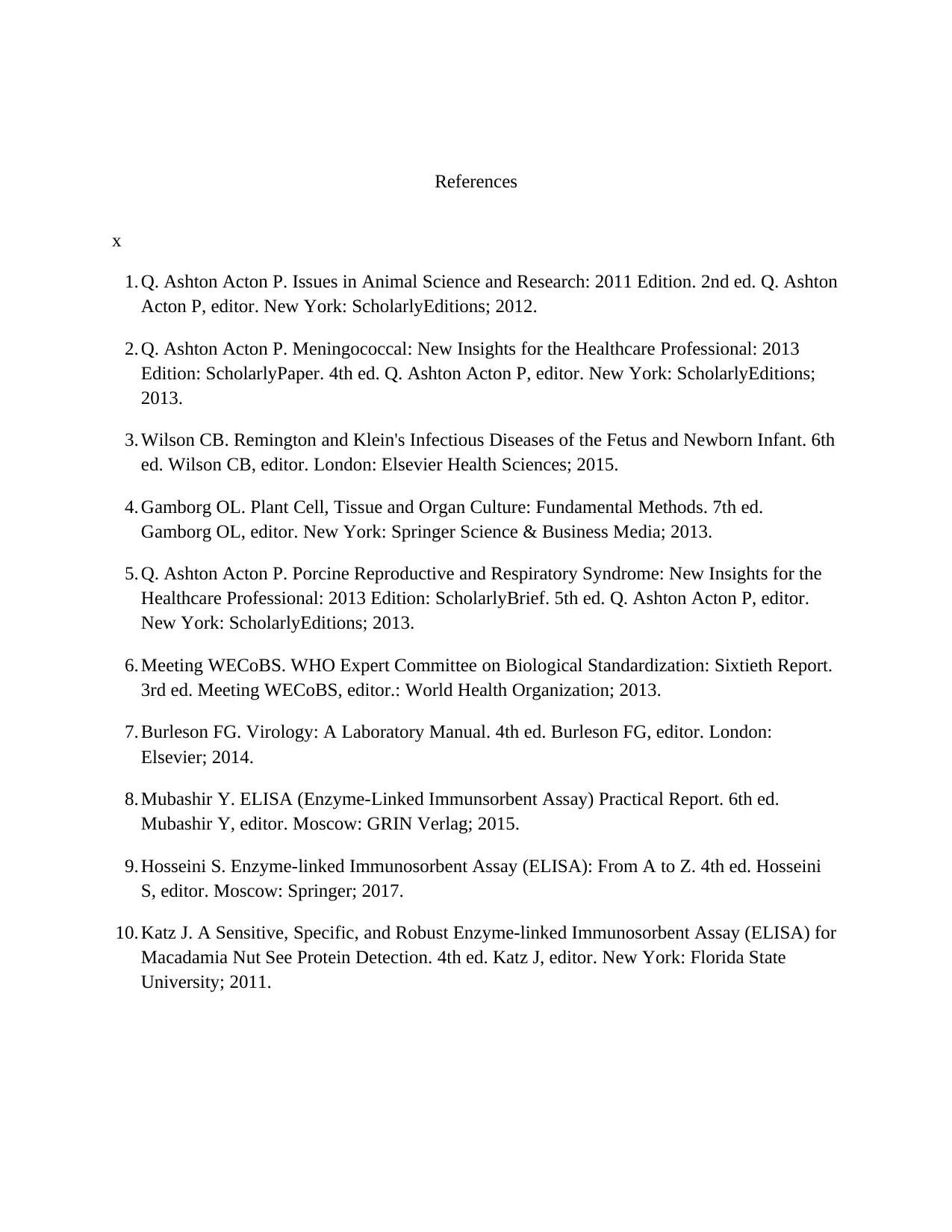
References
x
1. Q. Ashton Acton P. Issues in Animal Science and Research: 2011 Edition. 2nd ed. Q. Ashton
Acton P, editor. New York: ScholarlyEditions; 2012.
2. Q. Ashton Acton P. Meningococcal: New Insights for the Healthcare Professional: 2013
Edition: ScholarlyPaper. 4th ed. Q. Ashton Acton P, editor. New York: ScholarlyEditions;
2013.
3. Wilson CB. Remington and Klein's Infectious Diseases of the Fetus and Newborn Infant. 6th
ed. Wilson CB, editor. London: Elsevier Health Sciences; 2015.
4. Gamborg OL. Plant Cell, Tissue and Organ Culture: Fundamental Methods. 7th ed.
Gamborg OL, editor. New York: Springer Science & Business Media; 2013.
5. Q. Ashton Acton P. Porcine Reproductive and Respiratory Syndrome: New Insights for the
Healthcare Professional: 2013 Edition: ScholarlyBrief. 5th ed. Q. Ashton Acton P, editor.
New York: ScholarlyEditions; 2013.
6. Meeting WECoBS. WHO Expert Committee on Biological Standardization: Sixtieth Report.
3rd ed. Meeting WECoBS, editor.: World Health Organization; 2013.
7. Burleson FG. Virology: A Laboratory Manual. 4th ed. Burleson FG, editor. London:
Elsevier; 2014.
8. Mubashir Y. ELISA (Enzyme-Linked Immunsorbent Assay) Practical Report. 6th ed.
Mubashir Y, editor. Moscow: GRIN Verlag; 2015.
9. Hosseini S. Enzyme-linked Immunosorbent Assay (ELISA): From A to Z. 4th ed. Hosseini
S, editor. Moscow: Springer; 2017.
10. Katz J. A Sensitive, Specific, and Robust Enzyme-linked Immunosorbent Assay (ELISA) for
Macadamia Nut See Protein Detection. 4th ed. Katz J, editor. New York: Florida State
University; 2011.
x
1. Q. Ashton Acton P. Issues in Animal Science and Research: 2011 Edition. 2nd ed. Q. Ashton
Acton P, editor. New York: ScholarlyEditions; 2012.
2. Q. Ashton Acton P. Meningococcal: New Insights for the Healthcare Professional: 2013
Edition: ScholarlyPaper. 4th ed. Q. Ashton Acton P, editor. New York: ScholarlyEditions;
2013.
3. Wilson CB. Remington and Klein's Infectious Diseases of the Fetus and Newborn Infant. 6th
ed. Wilson CB, editor. London: Elsevier Health Sciences; 2015.
4. Gamborg OL. Plant Cell, Tissue and Organ Culture: Fundamental Methods. 7th ed.
Gamborg OL, editor. New York: Springer Science & Business Media; 2013.
5. Q. Ashton Acton P. Porcine Reproductive and Respiratory Syndrome: New Insights for the
Healthcare Professional: 2013 Edition: ScholarlyBrief. 5th ed. Q. Ashton Acton P, editor.
New York: ScholarlyEditions; 2013.
6. Meeting WECoBS. WHO Expert Committee on Biological Standardization: Sixtieth Report.
3rd ed. Meeting WECoBS, editor.: World Health Organization; 2013.
7. Burleson FG. Virology: A Laboratory Manual. 4th ed. Burleson FG, editor. London:
Elsevier; 2014.
8. Mubashir Y. ELISA (Enzyme-Linked Immunsorbent Assay) Practical Report. 6th ed.
Mubashir Y, editor. Moscow: GRIN Verlag; 2015.
9. Hosseini S. Enzyme-linked Immunosorbent Assay (ELISA): From A to Z. 4th ed. Hosseini
S, editor. Moscow: Springer; 2017.
10. Katz J. A Sensitive, Specific, and Robust Enzyme-linked Immunosorbent Assay (ELISA) for
Macadamia Nut See Protein Detection. 4th ed. Katz J, editor. New York: Florida State
University; 2011.
1 out of 10
Related Documents
Your All-in-One AI-Powered Toolkit for Academic Success.
+13062052269
info@desklib.com
Available 24*7 on WhatsApp / Email
![[object Object]](/_next/static/media/star-bottom.7253800d.svg)
Unlock your academic potential
Copyright © 2020–2025 A2Z Services. All Rights Reserved. Developed and managed by ZUCOL.





